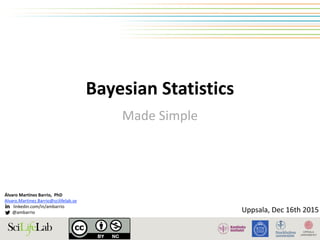Mol evol jc.151216-amb.bayesianstats-teaser
- 2. 2 Think Bayes Bayesian Statistics Made Simple Version 1.0.3 Allen B. Downey Green Tea Press Needham, Massachusetts
- 3. Notation: Probability 3 • p(A): the probability that A occurs ! • p(A|B): the probability that A occurs, given that B has occurred ! • p(A and B) = p(A) p(B|A): Conjoint probability
- 4. Introduction: Bayes’ Theorem 4 • By definition of conjoint probability and that conjunction is commutative: p(A and B) = p(A) p(B|A) = (1) p(B and A) = p(B) p(A|B) • p(A) p(B|A) = p(B) p(A|B) (2) • p(A|B) = p(A) p(B|A) / p(B) (3)
- 10. The “diachronic” interpretation 10 Thomas Bayes, (b. 1702, London - d. 1761, Tunbridge Wells, Kent) p(H|D) = p(H) p(D|H) / p(D) • p(H) is the probability of the hypothesis before we see the data, called the prior probability, or just prior. • p(H|D) is what we want to compute, the probability of the hypothesis aer we see the data, called the posterior. • p(D|H) is the probability of the data under the hypothesis, called the likelihood. • p(D) is the probability of the data under any hypothesis, called the normalizing constant.
- 11. History: Syllogism 11 4th century BC ! ! • Major premise ! ! • Minor premise ! ! • Conclusion A rhetorical syllogism (a 3-part deductive argument) used in oratorial practice.
- 12. History: Syllogism 12 4th century BC • Major premise: “All humans are mortal” ! ! • Minor premise: “All Greeks are human” ! • Conclusion: “All Greeks are mortal”
- 13. History: Syllogism 13 4th century BC • Major premise: “All mortals die” ! ! • Minor premise: “All men are mortals” ! • Conclusion: “All men die”
- 14. History: Enthymeme 14 4th century BC ! • “Socrates is mortal because he’s human” ! • Major premise (unstated): “All humans are mortal.” ! • Minor premise (stated): “Socrates is human.” ! • Conclusion (stated): “Therefore, Socrates is mortal.”
- 25. Chapter 2: Computational Statistics • Distribution: set of values and their corresponding probabilities. • Probability mass function: way to represent a distribution mathematically. • When talking about probabilities, you need to normalise (they should add up to 1)
- 26. Chapter 2: Computational Statistics • Distribution: set of values and their corresponding probabilities. • Probability mass function: way to represent a distribution mathematically. • When talking about probabilities, you need to normalise (they should add up to 1) • This distribution, which contains the priors for each hypothesis, is called (wait for it) the prior distribution. • To update the distribution based on new data (a vanilla cookie!), we multiply each prior by the corresponding likelihood. • The distribution is no longer normalized, you need to renormalize • The result is a distribution that contains the posterior probability for each hypothesis, which is called (wait again!) the posterior distribution.
- 27. Chapter 2: Computational Statistics • Distribution: set of values and their corresponding probabilities. • Probability mass function: way to represent a distribution mathematically. • When talking about probabilities, you need to normalise (they should add up to 1) • This distribution, which contains the priors for each hypothesis, is called (wait for it) the prior distribution. • To update the distribution based on new data (a vanilla cookie!), we multiply each prior by the corresponding likelihood. • The distribution is no longer normalized, you need to renormalize • The result is a distribution that contains the posterior probability for each hypothesis, which is called (wait again!) the posterior distribution. Terminology and design patterns of python programs that you can use during the rest of the course
- 39. Chapter 3: Estimation • Credible interval: For intervals we usually report two values computed so that there is a 90% chance that the unknown value falls between them (or any other probability). • The width of this interval suggests how uncertain we are about the conclusion based in our unknown value. • There are two approaches to choosing prior distributions: • i) informative: best represents background information • ii) uninformative: intended to be as unrestricted as possible
- 40. Chapter 3: Estimation • Credible interval: For intervals we usually report two values computed so that there is a 90% chance that the unknown value falls between them (or any other probability). • The width of this interval suggests how uncertain we are about the conclusion based in our unknown value. • There are two approaches to choosing prior distributions: • i) informative: best represents background information • ii) uninformative: intended to be as unrestricted as possible In real world you have two ways to proceed: ! If you have a lot of data, the choice of the prior doesn’t matter very much; informative and uninformative priors yield almost the same results. ! If you don’t have much data, using relevant background information makes a big difference.
- 42. Differences between Bayesians and Non-Bayesians According to Jeff Gill (Center for Applied Statistics, WashU) ACCP 37th Annual Meeting, Philadelphia, PA [2] Differences Between Bayesians and Non-Bayesians According to my friend Jeff Gill Typical Bayesian Typical Non-BayesianTypical Bayesian
- 43. Differences between Bayesians and Non-Bayesians ACCP 37th Annual Meeting, Philadelphia, PA [2] Differences Between Bayesians and Non-Bayesians According to my friend Jeff Gill Typical Bayesian Typical Non-BayesianTypical Bayesian ACCP 37th Annual Meeting, Philadelphia, PA [2] Differences Between Bayesians and Non-Bayesians According to my friend Jeff Gill Typical Bayesian Typical Non-BayesianTypical Non-Bayesian According to Jeff Gill (Center for Applied Statistics, WashU)
- 44. Conclusions • Importance of modelling • Follow a discrete approach: correct first, and expand later
- 48. REFERENCES • PyCon tutorials (by Allen Downey) https://sites.google.com/site/simplebayes/ ! • “Probably Overthinking It” (by Allen Downey) http://allendowney.blogspot.se/ ! • Mark A. Beaumont & Bruce Rannala (2004) Nature Rev Genetics Monument to members of the Bayes and Cotton families, including Thomas Bayes and his father Joshua, in Bunhill Fields burial ground

